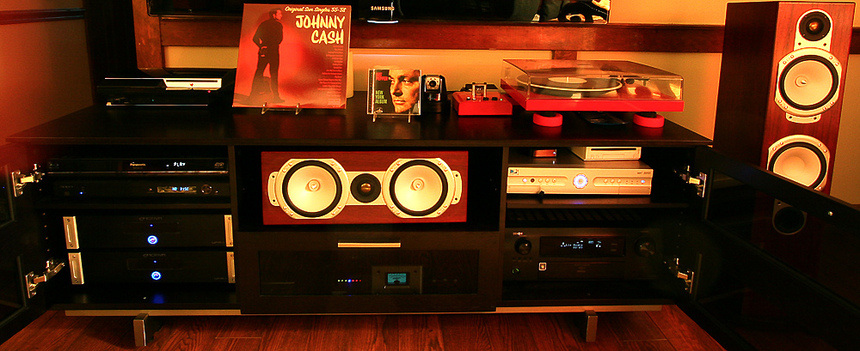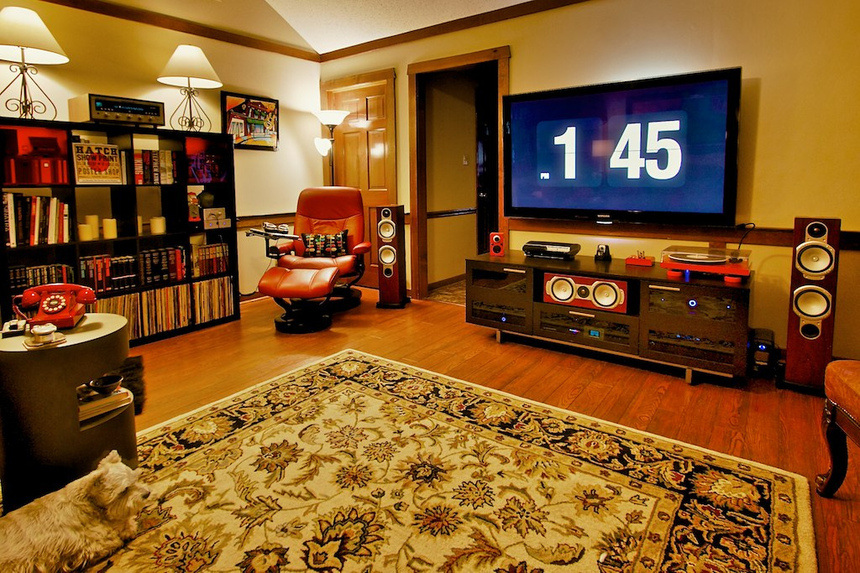Note: I get paid commissions for purchases made through any links to Amazon products in this post.
The 2010 Mini is not the highest spec'd computer. It has a 2.4Ghz Intel Core 2 Duo processor and I upgraded the RAM to 8GBs. However, the small size, energy efficiency, and quiet fan make this computer a perfect compliment for most home theaters.
Before I discuss the way I use the Mini, I do want to mention that I looked into playing hi-rez movie soundtracks (True-HD and DTS-HD) and it was not supported the last time I checked. If this is important to you, I would recommend researching further or just picking up a Windows computer instead. You can hook up a Blu-ray drive to the mini, but you would need special software to play it and (from what I understand) you would still lose the hi rez soundtracks.
I discovered that I liked OSX mainly because it gave me a different experience at home than at work, where we run Windows. As a result, in 2011, I bought an iMac, which freed the Mini to be used exclusively for media. However, I decided to keep it sitting on my desk in the office since my office shares a wall with my home theater system and it would give me easier access since I could use the DVI output to feed a monitor in the office and "mini-display to HDMI" to feed a Denon receiver in our living room (where we keep our "home theater"). I simply mirror the display so that the same thing shows up in both rooms. I believe there may be a performance hit for mirroring, but it runs fine, so I haven't tried to get around the issue, which would be easy with an HDMI splitter. Another advantage of having it in a separate room is that the fan can get louder if you are doing something that taxes its power reserves.
The most important aspect of using a Mini for media is the programs you decide to use with it. Below is a list of some of the most useful programs that I run:
1. iTunes - I don't have a problem using iTunes to manage my music. If you have an iOS device (and I would highly recommend getting one to use with the Mac Mini) there is a "Remote" app from Apple that will control playback and make it easy to chose music from your library. If you have Airplay devices, you can also choose where the signal is played. It works with multiple Airplay speakers without Airfoil, so that is a plus, as well.
2. Audiotap - This is an app that runs alongside iTunes. It is for streaming your music to an iDevice anywhere that has an internet connection. It will work with lossless files on wifi.
3. Plex - This is a slick media interface that will allow you to access your own media and some plug ins (like Cnet video and Twittv). Plex also has a well received paid service that I don't currently use.
4. XBMC (soon to be Kodi Entertainment Center) - This is a bit geekier than Plex. It is more of a hobby, but has more third party apps available.
5. Rowmote - As I mentioned, I recommend an iOS device to control the Mini and this is an amazing app that will allow you to use that iOS device as a keyboard and mouse. Since I have the Mini in a separate room, I do have a regular keyboard and mouse hooked to them, but most of the time I control it with my iPhone. One other cool thing about the app is that has a list of applications, and when you click on one, it will launch.
6. Splashtop - You can also use this to control the Mac Mini via an iOS device or laptop. The plus to this is that you can take complete control of the computer without needing to have your TV on. Very useful for music.
7. Rdio/Spotify - I have both of these in use now. Spotify currently has better sound quality and you can control it running on your computer via "Remoteless" app on iOS or Splashtop. Rdio can be controlled, once you have it playing, with the Rdio app on your iOS device. I prefer Rdio unless I need ultimate sound quality, which unfortunately is a lot of the time.
8. Airfoil - This app will allow you to send any audio from your Mini to any Airplay device. I have numerous Airplay devices, so this comes in handy. One cool feature is that it will turn your Mini into an Airplay receiver and then you can send audio to any or all of your Airplay devices. There are also a couple Airfoil apps for iOS. Airfoil Speakers (for iOS) will turn your iPhone/iPad into an Airplay receiver for your computer. AF Remote app (for iOS) lets you control the Airplay devices that will receive a signal without sitting in front of a computer. It will also provide some control of the audio program that is playing, like volume, stop and play.
9. Roomie Auxillary - I have written about Roomie Remote for iOS and this plug-in works great. It allows the user to launch and control programs at the touch of a button.
9. Eyetv HD - I use this to occasionally record programs from Directv. It receives a signal from the component outputs on the satellite box and sends the signal to the Mini via USB. It can't record surround sound, but it is still useful. It also streams to iPads and iPhones and can be Airplayed to AppleTV.
10. Slingbox - For me, this is a better way of getting TV on the Mini. Its a box that plugs into a satellite box and ethernet and will display the signal on the Mini (or iOS device). It won't record programs like the Eyetv, but it is less "buggy" for streaming a signal wherever you are (with internet). When the Directv box in our home theater started to have issues, we used the Mini to stream video from our satellite box in the bedroom until we were able to get Directv out to fix it.
11. Kylo - This is an interesting app that will allow you to easily launch sites like Netflix, Pandora, etc.. It essentially a web browser with links to some of the most popular sites and it can be resized for easier viewing on a television. It hasn't been updated in years, but their site still has it available for download.
12. Fidelia - This is a somewhat expensive app that improves sound quality of your files on a Mac. I mainly use it for its nifty headphone settings. It also has a useful iOS app so you can control the music (similar to the Remote app).
13. Bitperfect - another app for improving sound quality from the Mac. It works with iTunes, so you can control it with the Remote app. It is also a lot cheaper than Fidelia, will perform bitrate changes on the fly (in other words, if you play a 16/44.1 file and then play a 24/96 file it will play them in their native resolution. iTunes doesn't.), but it doesn't have the great headphone features of Fidelia. I also use the Mini to feed a headphone setup using a USB output, so I like those extra features.
14. I also run some special screensavers, one is clock like you see in the pic below the article and the other is an aquarium app that has realistic fish that swim across your screen. There is another that pulls up album art.
The above are the main apps I run from OSX, but you can always find others to fit your taste and needs. For example, some people don't like iTunes, so there are options that might fit their needs better. I should mention that Vudu has an issue playing HDX files on my Mini. It says there are HDCP issues so it will only play SD files. As a result, I usually use Roku if I want to watch a movie on Vudu. I have read about some third pary HDMI splitters that strip the HDCP, but I have never used them.
Besides the numerous ways to play music directly, it also serves up files to Appletv via iTunes and Roku via Plex. It can also run apps like Tversity that work well with the PS3.
One benefit of using Macs is that they are easy to partition with Bootcamp and can also use Windows. At one point, I prefered Windows Media Center to Plex, so I run Windows8 (I "upgraded" from Win7) via VMWare Fusion (an app that allows both operating systems to be running and accessible at the same time). I also have JRiver Media Center running on Windows (bought it before it was added to OSX). This is just another media app, but it is cheaper than Fidelia and has some of the same headphone settings. It sounds great and you can also control it with an app called JRemote. JRemote works with DLNA devices and Airplay devices. Obviously, with a Windows partition, you can play some lower-end (less taxing) games. If you go this route, you will probably want a real mouse rather than using an iOS device as a remote. I have never used it this way, but I may try it at some point.
As you can tell, the Mini has some great media server features and, for me, it's benefits outweigh some of its shortfalls. The fact that it burns little electricity and can run more apps than my NAS makes it the perfect compliment to the many audio and video systems I have around the house. If you are thinking about going this route and have questions, please leave a comment or send me an email.


 RSS Feed
RSS Feed